Many superb exhibitions opened, as ever, in and around last month’s Frieze week in London. But for concept, design, breadth and quality of work—and for sheer revelation—none beats The Imaginary Institution of India at the Barbican Art Gallery.
Its triumph lies in its astute traversal of the terrain of art and geopolitics—an area of exhibitions that is littered with clunkiness and earnest failure. There is little interpretation on the Barbican’s walls; instead, numbers point to entries in a pocket-sized booklet. The show asks us to confront the works first, to grapple with their materiality and iconography, before we read about their stories. It succeeds so abundantly because it trusts us, as viewers, to connect form and complex content.
The Emergency
A long-cherished project of the Barbican’s head of visual arts, Shanay Jhaveri, the show looks at the years between 1975—when the then prime minister Indira Gandhi declared an emergency to try to stem a tide of opposition to her premiership, in effect ending post-independence civil liberties—and India’s May 1998 nuclear tests in Pokhran. The successful tests reflected the nation’s fraught departure from the ideals of non-violence at the heart of the independence struggle.
Jhaveri writes in the catalogue that the show is not meant as a “study” of the Emergency, so much as “what it signalled and how it provoked the collective artistic imaginary, directly or indirectly”. Among the most profound effects was the opening up of artistic languages with which to respond. Arguably the pivotal event in that period happened in December 1992, when the Babri Masjid, a mosque in Ayodhya in northern India, was destroyed by a Hindu mob. The destroyers included members of the BJP, the Hindu nationalist party of the present Indian prime minister, Narendra Modi. Waves of violence followed across the country, leaving thousands of people, mostly Muslims, dead, and thousands more displaced.
Informed by activism
Among the artists who responded most viscerally was Rummana Hussain. A Muslim woman based in Mumbai, she was forced to leave her home with her family amid the disturbances that followed the destruction of the mosque. And she shifted her entire practice as a result, moving from figurative painting to sculptural and mixed-media installation, informed by activism, as a means of trying “to make sense of the impact sectarian violence and disharmony had on her sense of belonging”, as Jhaveri writes. Born into a family committed to the secular humanist vision of India embodied by Gandhi’s father, Jawaharlal Nehru, India’s first prime minister, Hussain saw art as a means of reinforcing those ideals. The art critic Geeta Kapur later wrote that fearing the loss of a secular future, “with help of her own body [Hussain] proposes to suture the social wound”.
Composed of smashed and cleaved terracotta pots, earth and pigment, as well as prints and photography, Hussain’s 1993 installations in the Barbican evoke architectural destruction, while alluding to the effects of the events on human bodies. Mirrors project shadows on to the wall that suggest shattered figures and, in one work, lungs.
I was deeply moved; Hussain translates a moment of personal trauma amid national disharmony—arguably the most important single event in defining modern India—into a language of feeling. “It’s necessary to emerge from our insular shells, to come together and try and develop symbols of secularism,” she wrote. “A coming together of artists and viewers is a form of public participation, one that emphasises the commonality of all.” For her, art and political action were inescapably intertwined, an embeddedness the Barbican show so deftly reflects.
• The Imaginary Institution of India: Art 1975-1998, Barbican Art Gallery, London, until 5 January 2025


